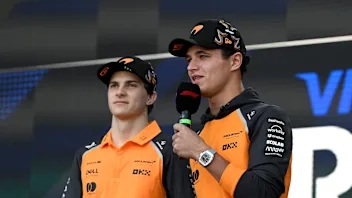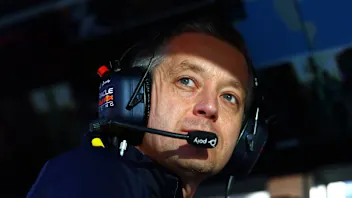Having joined Mercedes midway through 2013, executive director (technical) Paddy Lowe quickly became involved in the Brackley squad’s 2014 car programme.
On Tuesday, as the team took the covers off the F1 W05 in Jerez, Lowe discussed the new car’s development, from the impact of the regulation changes to the challenges of integrating a new power unit…
Q: How significant is the change in technical regulations for the 2014 season?
Paddy Lowe: For 2014 we have probably the greatest change in regulations in Formula One history. The headline is 'efficiency'. The fact that we can run a full race on 100kg rather than 150kg of fuel sends a great message about the technology we can deliver for Formula One - and gives an important message to the automotive world in general. It's not simply about the fuel saved per car on a Sunday afternoon, it's about the technology itself. Over the years, we have seen how relatively small things filter through to the production world, not just in terms of the cars themselves but also what is seen as attractive. We are part of that and it is what Formula One should be doing. It's a great opportunity for Mercedes-Benz and Petronas to take those regulations and show we can do better than our competitors. The coming weeks will tell if we have managed that or not.
Q: How has the chassis team had to adapt to the change in Power Unit?
PL: The Power Unit (PU) has a completely different shape and requirements to its predecessor and it is the biggest change in packaging in Formula One for many years. There is a lot more equipment to cool: more Hybrid systems plus the intercooler for the charge air from the turbocharger. That has both a packaging and an aerodynamic dimension. Then there is the weight challenge. Although the minimum weight has been raised to 691 kg, it is far more difficult to achieve than last year's target because of the extra equipment in the Power Unit and its associated systems, plus the cooling demand and the new, heavier side impact structures prescribed by the FIA. Yet another aspect is the thermal challenge. With the introduction of a turbocharger, managing the heat around the exhaust system is important for both car integrity and also for performance. If losses can be minimised in the primaries between the engine block and turbo, that is energy that can be recovered and used for car performance. So there is a big insulation and heat management challenge for both integrity and performance reasons.
Q: What impact have the increased energy recovery requirements had for the chassis team?
PL: We have doubled the amount of kinetic energy that is permitted to be recovered through the rear axle relative to the previous KERS systems. This means that rear brake duty, and therefore the quantity of heat generated, will be far lower. We have automatic systems recovering the energy and so, in order to maintain a driveable brake balance, the rear brakes are permitted to be controlled electronically. We have designed a 'brake-by-wire' system for the rear wheels. When the driver presses the pedal, the system manages the rear brake circuit and the energy recovery requirements together so that the total rear braking effort and the net front-to-rear brake balance matches the driver's demand. The most important aspect to get right with brake-by-wire is failure management. It is obviously a safety critical system and most of our work has been focused around ensuring the right levels of failure control.
Q: Reliability has been spoken about often in connection with the Power Units. Does this present any challenges on the chassis side?
PL: We do have new durability targets to meet, most particularly in relation to the gearbox. It is an entirely new design: it now includes eight speeds, the lower engine speed means a new regime of reduction ratios, there is significantly more torque and the gear ratios must be nominated for the entire season. That means we are not just being stretched in terms of new functionality but also in terms of endurance. Previously, we would re-optimise gear ratios every weekend. The new PU has a wide range of workable engine speeds, which means that ratio choice is nothing like as critical as it was in the past. But the more difficult part is making the physical ratios last for six races instead of one - and indeed making the whole gearbox system last for six races, compared to five last year.
Q: The aerodynamic regulations have also seen significant changes for the new season...
PL: The package of aerodynamic modifications is probably as significant as the changes introduced for the start of the 2009 season. It comprises three main elements. First, the front wing has been narrowed, which has a fundamental effect on the flow field of the car, because the wake from the front wing is its first defining point. Second, at the rear, we have been affected by the loss of exhaust blowing, which was a very significant aspect of car performance in the past three seasons. With the single central exit tailpipe, it has been a challenge to recover the driveability which was very strong as the drivers came on throttle on corner exit. Finally, the rear wing has been altered with the elimination of the lower rear wing and about a 10 percent reduction in the 'legality box' for the upper rear wing, from 220 mm to 200 mm. At the rear of the car, the floor, lower rear wing and upper wing previously worked as a set and that has now changed, which presents a challenge. Overall, we are obliged to run broadly the same level of wing that we would previously have run at Spa in a 'low-drag' configuration. This will mean reduced cornering speeds but also higher straightline speeds.
Q: The Sporting Regulations also now include restrictions on wind tunnel usage. Can you explain their impact?
PL: The teams have policed restrictions on wind tunnel and computational fluid dynamics (CFD) usage for several years now. For 2014 this practice has been written into the Sporting Regulations and will be policed by the FIA. Furthermore the amount of permitted testing has been severely reduced in order to save costs: wind tunnel occupancy is restricted to 60 hours per week (teams had typically been running 24x7), we can only run 80 wind tunnel tests per week, the trading combination between wind tunnel and CFD usage has been further restricted (so-called '30/30' rule) and we have lost the ability to perform full-scale aerodynamic tests in the wind tunnel or on runways. In real terms, that represents an overall reduction in aerodynamic testing of around two thirds.
Q: How satisfied are you with the F1 W05 as a response to the new regulations?
PL: The team has done a fantastic job on each aspect of the project. We have hit our milestones and also our own internal targets. The car is an elegant response to the new regulations but also an aggressive design and, as is often the way, its beauty is much more than skin deep; the internal engineering is extremely innovative and intelligent. I am very proud of the work that has gone into the project so far, which is a huge credit to Bob Bell, Aldo Costa, Geoff Willis, Rob Thomas and the engineering team. Of course everybody is also well aware of how much remains to be done throughout the season; we are only just beginning!
Q: How critical will in-season development prove to be this year, in your opinion?
PL: Formula One is always a development race. The team that can extract the most lap-time benefit from the new wind tunnel restrictions will be rewarded for it, especially so early in a new set of regulations when the development curve is at its steepest. But it won't just be about aerodynamics: owing to the fuel restrictions, the efficiency challenge is possibly the biggest one of all. This is where, for example, our technology partnership with Petronas can and will make a significant difference. And finally we must not forget reliability. We are breaking new ground with a number of the technologies in the car but they are of little use if we do not make it to the finish line at each race. So we will be fighting on every front to meet technical and durability challenges this year. And that is exactly what Formula One should be about: adopting and stretching innovative technologies in the most aggressive and ambitious way possible.
Next Up
Related Articles
/TWGMS-F1-Announcement-1298%20(1)%20(1).webp) ExplainedEverything you need to know about Cadillac’s entry to F1
ExplainedEverything you need to know about Cadillac’s entry to F1.webp) End Of Year Reports 2025Mercedes’ best and worst moments from 2025
End Of Year Reports 2025Mercedes’ best and worst moments from 2025 Piastri not expecting Norris’ title to change dynamics
Piastri not expecting Norris’ title to change dynamics.webp) How F1 drivers recharge during the winter break
How F1 drivers recharge during the winter break.webp) ExclusiveZhou on why he has ‘high trust’ in Cadillac project
ExclusiveZhou on why he has ‘high trust’ in Cadillac project Former Red Bull strategy chief Courtenay starts at McLaren
Former Red Bull strategy chief Courtenay starts at McLaren